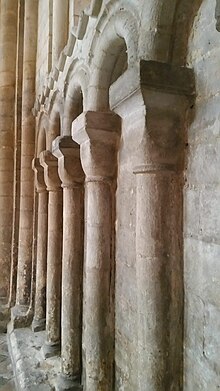
Back رواق مقنطر Arabic Arkada Azerbaijani Аркада (архітэктура) Byelorussian Аркада (архітэктура) BE-X-OLD Аркада Bulgarian Arkada BS Arcada Catalan Arkáda (architektura) Czech Arkade Danish Arkade German

An arcade is a succession of contiguous arches, with each arch supported by a colonnade of columns or piers. Exterior arcades are designed to provide a sheltered walkway for pedestrians; they include many loggias, but here arches are not an essential element. An arcade may feature arches on both sides of the walkway. Alternatively, a blind arcade superimposes arcading against a solid wall.[1]
Blind arcades are a feature of Romanesque architecture that influenced Gothic architecture. In the Gothic architectural tradition, the arcade can be located in the interior, in the lowest part of the wall of the nave, supporting the triforium and the clerestory in a cathedral,[2] or on the exterior, in which they are usually part of the walkways that surround the courtyard and cloisters.
A different, related meaning is "a covered passage with shops on one or both sides".[3] Many medieval open arcades housed shops or stalls, either in the arcaded space itself, or set into the main wall behind. From this, "arcade" has become a general word for a group of shops in a single building, regardless of the architectural form.
The word "arcade" comes from French arcade from Provençal arcada or Italian arcata, based on Latin arcus, ‘bow’ (see arc and arch).[4]
A related but ambiguous term is arcature, which is either a small arcade or a blind arcade.[5][6]
- ^ James Bettley and Nikolaus Pevsner (2007), Essex. The buildings of England, Yale University Press, page 865
- ^ William Chambers (1973), Chambers's encyclopaedia, Volume 1, International Learning Systems Corp, p. 534
- ^
- John Fleming, Hugh Honour and Nikolaus Pevsner, The Penguin Dictionary of Architecture, p. 16, 3rd edn, 1980, Penguin, ISBN 0140510133
- ^ New Oxford American Dictionary
- ^ "arcature". Merriam-Webster.com Dictionary. Merriam-Webster. "1. a small arcade (as in a balustrade). 2. a blind arcade, especially one that is decorative rather than structural."
- ^ Lockwood, Luke Vincent (1913). The Furniture Collectors' Glossary. Walpole Society.
ARCATURE . — A small arcade formed by a series of little arches. It may be blind or open.